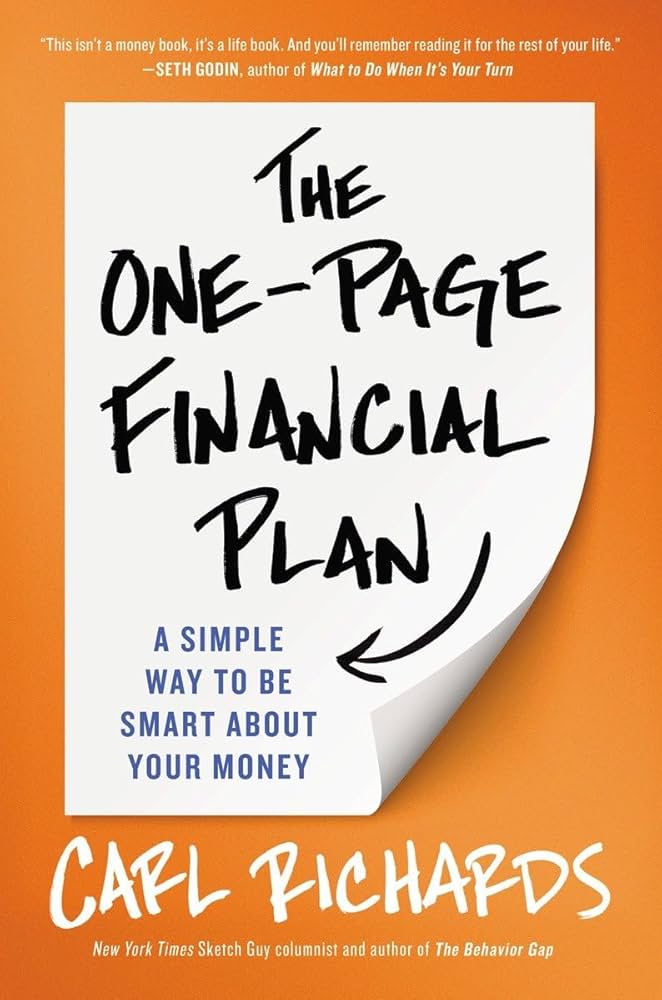The One-Page Financial Plan (Carl Richards)
What Resonated with Me
The emphasis on simplicity and the importance of creating a flexible financial plan that can adapt to life’s uncertainties resonates with me. The concept of asking “Why is money important to me?” to uncover deeper values and motivations is particularly insightful. I appreciate the practical advice on setting realistic financial goals, tracking spending, and focusing on what truly matters. The idea of focusing on the process rather than perfection aligns with my approach to personal finance.
Summary
“The One-Page Financial Plan” by Carl Richards is a guide to creating a simple, adaptable financial plan. Richards emphasizes the importance of understanding why money matters to you, setting realistic financial goals, and focusing on the process of financial planning rather than striving for perfection. The book offers practical advice on tracking spending, setting up a personal balance sheet, and making financial decisions that align with your values.
3 Key Takeaways
Understand Your Values
The first step in creating a financial plan is understanding why money is important to you. This involves asking yourself deep questions to uncover your values and motivations, which will guide your financial decisions.
A simple, one-page financial plan that can adapt to changes is more effective than a complex, rigid plan. Focus on setting realistic goals and automating processes to reduce the temptation to stray from your plan.
Tracking your spending helps you become aware of your financial habits and align them with your values. Setting specific, realistic goals based on your priorities allows you to make informed financial decisions.
How-To Guide: Practical Steps for Financial Planning
A comprehensive guide providing actionable steps to create and maintain a simple, adaptable financial plan that aligns with your values and goals.
How to Discover Your Financial Values
- Ask Deep Questions: Reflect on why money is important to you. Consider questions like:
- What do you want your money to accomplish?
- How do you want to feel about your financial situation?
- What are your biggest financial worries and dreams?
- Identify Core Values: Determine what truly matters to you, such as security, freedom, family, or travel. Use these values to guide your financial decisions.
- Write Down Your Values: Document your values and refer to them when making financial choices to ensure alignment with your core beliefs.
How to Set Realistic Financial Goals
- Define Specific Goals: Set clear, specific goals with measurable outcomes. Examples include saving for a down payment, paying off debt, or building an emergency fund.
- Prioritize Goals: Rank your goals based on importance and urgency. Focus on one or two primary goals at a time to maintain focus and motivation.
- Break Down Goals: Divide larger goals into smaller, manageable steps. This makes them less overwhelming and easier to achieve.
- Set Deadlines: Establish realistic timelines for achieving your goals. Deadlines provide motivation and a sense of urgency.
- Track Progress: Monitor your progress regularly and celebrate milestones. Adjust your plan as needed to stay on course.

How to Create a Personal Balance Sheet
- List Assets: Include everything you own, such as cash, investments, real estate, and personal property. Record their current values.
- List Liabilities: Document all debts, including mortgages, car loans, student loans, and credit card debt. Note the outstanding balances.
- Calculate Net Worth: Subtract total liabilities from total assets to determine your net worth. This provides a clear picture of your financial situation.
- Update Regularly: Review and update your balance sheet periodically to track progress and make informed financial decisions.
How to Track Spending and Budget
- Track Spending: Monitor all expenses for a month to understand where your money is going. Use apps, spreadsheets, or a notebook for accuracy.
- Categorize Expenses: Group expenses into categories such as housing, food, transportation, entertainment, and savings.
- Analyze Spending: Compare your spending to your income. Identify areas where you can cut back and align your spending with your values.
- Create a Budget: Set spending limits for each category based on your analysis. Ensure your budget reflects your priorities and goals.
- Review and Adjust: Regularly review your budget and adjust as needed to stay on track and accommodate changes in your financial situation.
Interesting Quotes
Other Notes
- Discovery Phase: This phase involves asking deep questions to understand your values and why money is important to you. It’s about uncovering what you want from money and from life.
- Creating a Personal Balance Sheet: List your assets and liabilities to get a clear picture of your financial situation. This clarity is essential for setting realistic financial goals.
- Importance of Budgeting: Budgeting is not just about numbers but about awareness. It helps you become aware of how you’re spending your money and ensures your spending aligns with your values.
- Setting Realistic Goals: Set specific, realistic goals based on your priorities. Use guesswork as a starting point and adjust as needed. This approach reduces anxiety about the future and allows for flexibility.
- Automating Savings: Automate your savings to make the process easier and more consistent. This helps you avoid the temptation to spend money meant for savings.
- Dealing with Debt: Paying down debt is an investment with a guaranteed return. Focus on the highest interest debt first to maximize the benefit.
- Life Insurance: Life insurance is about replacing economic loss, not an investment. Determine if you need it based on whether someone depends on you economically.
- Investment Strategy: Focus on sustainable investment decisions that reflect your goals and values. Avoid making decisions based on short-term thinking and emotion.
Every week, I’ll be sharing practical tips and invaluable knowledge to guide you on your path to financial independence.

Very good summary and a practical plan indeed! Thanks to my wife, we have tracked down all our expenses, income sources, cash flows (at least those that are predictable) and networth. I’d say at this stage our biggest worry is more of continuing to do meaningful work (and do good to the world) as opposed to just accumulating yet more wealth. Next year when I hit 55, I will be taking an even closer look at what we’re doing, and what we can do sustainably for the next 10 years – whether to continue status quo, slow down certain parts, or stop altogether and pivot towards something totally different.